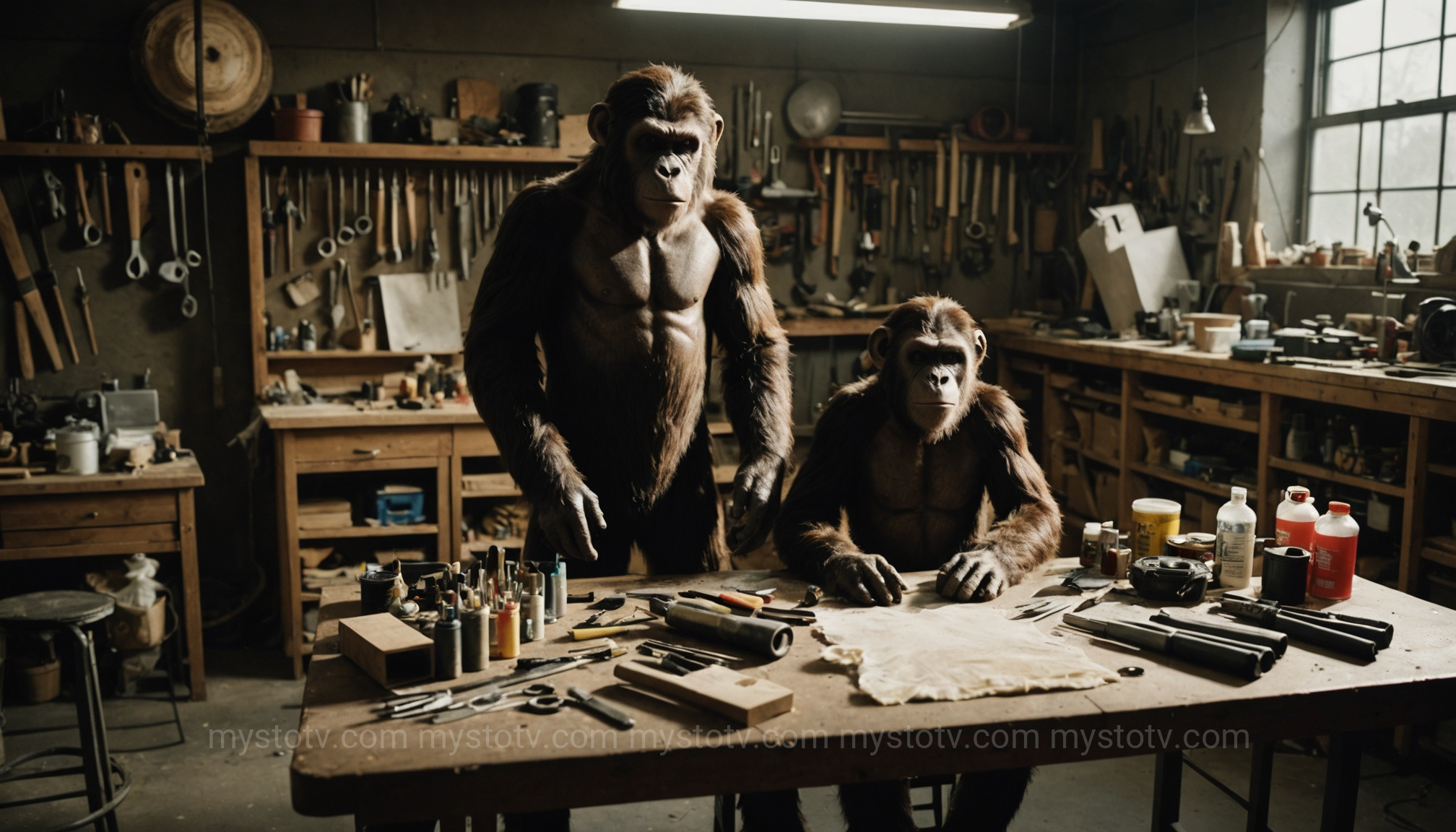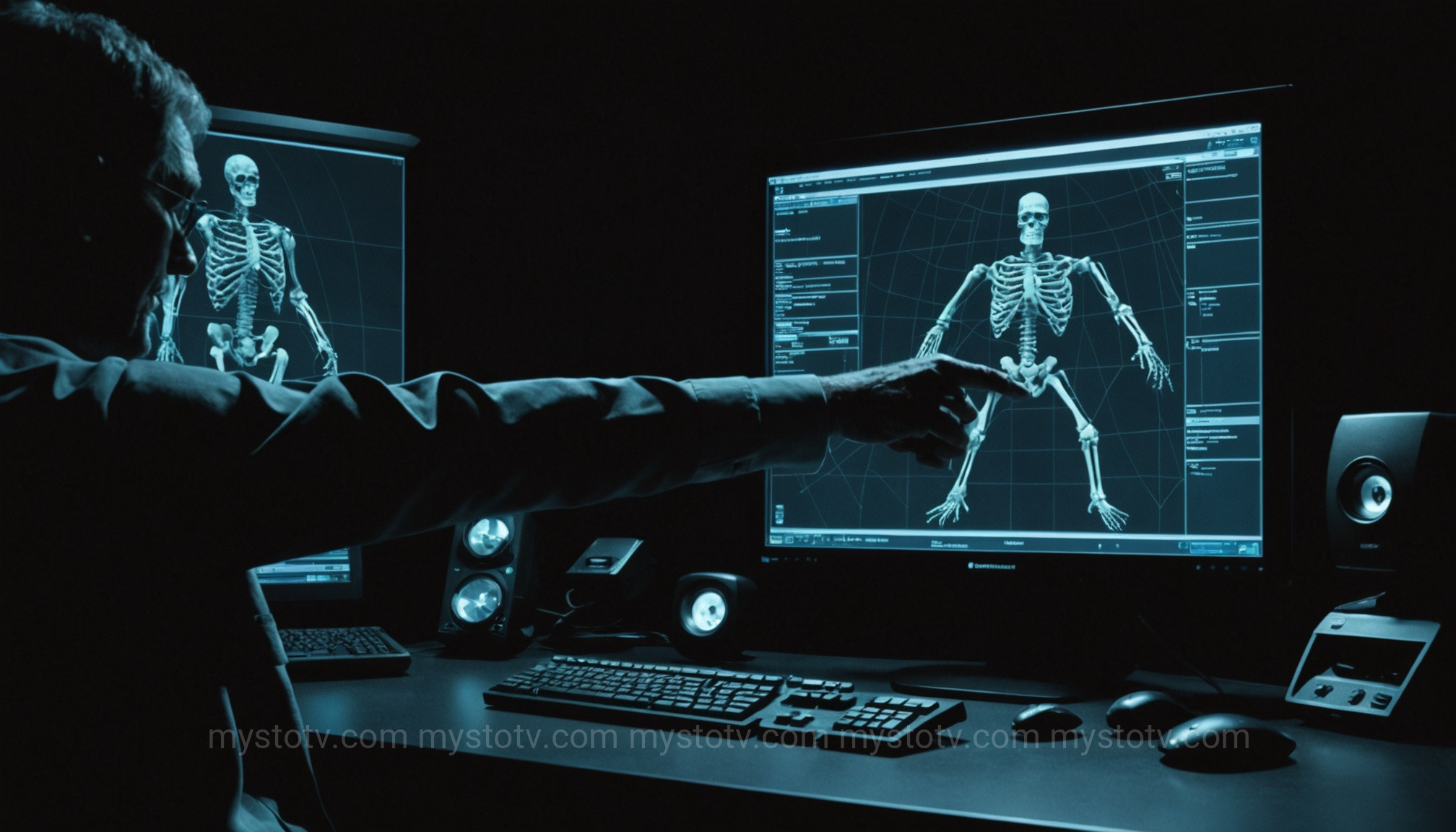I remember my first encounter with the Patterson-Gimlin film. It wasn’t in a dense forest, but on a grainy television screen during a late-night documentary. The shaky footage of a large, ape-like creature striding across a California creek bed was mesmerizing. For a moment, I was a believer. But my natural curiosity soon gave way to a healthy dose of skepticism. How could this be real? This early experience ignited a long-standing fascination not with Bigfoot itself, but with the process of belief and the critical examination of extraordinary claims. It’s this drive for objective truth that forms the foundation of any serious bigfoot evidence analysis. The Patterson-Gimlin film, for all its fame, demands nothing less than a rigorous, evidence-based deconstruction, separating folkloric allure from verifiable fact.
Contents
- 1 The Enduring Legend of the Patterson-Gimlin Film: A Critical Bigfoot Evidence Analysis
- 2 Arguments for Authenticity: A Bigfoot Evidence Analysis Perspective
- 3 The Case for a Hoax: A Skeptic's Bigfoot Evidence Analysis
- 4 Modern Scrutiny and Technological Bigfoot Evidence Analysis
- 5 The Human Element: Motive, Money, and a Bigfoot Evidence Analysis of the Storytellers
- 6 Frequently Asked Questions: A Deeper Bigfoot Evidence Analysis
- 7 References
- 8 Conclusion: The Verdict of a Skeptical Bigfoot Evidence Analysis
The Enduring Legend of the Patterson-Gimlin Film: A Critical Bigfoot Evidence Analysis

On October 20, 1967, former rodeo riders Roger Patterson and Robert "Bob" Gimlin rode on horseback into the Six Rivers National Forest near Bluff Creek, California. Their goal, they claimed, was to shoot a documentary about the legend of Bigfoot. What they captured instead became Frame 352 of their 16mm film reel—an iconic image that has defined the Sasquatch phenomenon for over half a century. The minute-long footage depicts a large, bipedal, hair-covered creature, dubbed "Patty," walking away from the camera, turning briefly to look back before disappearing into the woods.
The film's impact was immediate and profound. Unlike blurry photos or dubious plaster casts, this was moving footage. It presented a subject with apparent musculature, a distinct gait, and a seemingly natural presence. For believers, it was the "smoking gun," the irrefutable proof that a species of North American ape existed. For skeptics, it was the most audacious and successful hoax ever perpetrated. The ongoing debate is central to the field of cryptozoology and serves as a masterclass in the challenges of conducting a proper bigfoot evidence analysis when faced with a singular, unrepeatable event.
The significance of the P-G film cannot be overstated. It anchors the entire modern Bigfoot narrative. Every subsequent piece of "evidence"—from audio recordings to hair samples—is implicitly compared to it. Therefore, a thorough, skeptical analysis of this film is not just an academic exercise; it's a necessary step in evaluating the entire premise of the creature's existence.
Arguments for Authenticity: A Bigfoot Evidence Analysis Perspective
To conduct a fair and balanced bigfoot evidence analysis, it's crucial to first understand and acknowledge the arguments supporting the film's authenticity. Dismissing them out of hand is unscientific. Proponents of the film, including some notable academics, have built a compelling case over the decades, focusing primarily on anatomical and biomechanical details that they argue would have been impossible to fake in 1967.
Anatomical and Muscular Detail
The most powerful argument for authenticity lies in the subject's body. As Patty walks, muscles appear to flex and ripple beneath the fur in a way that seems biologically authentic. Proponents, like the late Washington State University anthropologist Dr. Grover Krantz, argued that the visible muscle groups—particularly in the back, shoulders, and thighs—move in a manner consistent with a living creature, not a person in a simple fur suit. They point to the deltoids, trapezius, and quadriceps, which appear to contract and relax with each step. The challenge for skeptics is to explain how a special effects artist in 1967, on a shoestring budget, could create a suit with such sophisticated, dynamic musculature, long before the advent of the advanced animatronics and CGI seen in modern cinema.
The Biomechanics of the "Compliance Gait"
Dr. Jeff Meldrum, an Professor of Anatomy and Anthropology at Idaho State University, is a prominent modern proponent of the film's authenticity. His analysis focuses on the creature's unique walk, which he terms a "compliance gait." Patty walks with bent knees and a bent ankle, a posture that would be incredibly difficult and strenuous for a human to maintain for any length of time. This gait, combined with a pronounced mid-tarsal break (a flexibility in the middle of the foot not present in humans), suggests a bipedal locomotion that is distinctly non-human. Proponents argue that fabricating such a complex and subtle gait, one that wasn't even properly analyzed or understood by biomechanics experts until decades later, would have required a level of genius and foresight far beyond that of a simple hoaxer.
Expert Opinions and Early Analysis
In the years immediately following the film's release, Patterson sought validation from experts. While many dismissed it, some were intrigued. Dr. D.W. Grieve, a British anatomist and expert in human locomotion, analyzed the film in 1971 for the BBC. While he stopped short of declaring it authentic, he concluded, "My subjective impressions have swung towards the film being a hoax... but I am not yet convinced." He calculated the creature's weight and height, finding the proportions to be internally consistent. He noted the difficulty a human would have in replicating the walk. This professional hesitance from a qualified expert lends a degree of credibility to the film that a simple dismissal cannot erase. The core of the pro-authenticity argument is this: the subject in the film displays biological and biomechanical traits that were either impossible or highly improbable to fake with the technology and knowledge available in 1967.
The Case for a Hoax: A Skeptic's Bigfoot Evidence Analysis

While the arguments for authenticity are compelling on the surface, a deeper, more critical bigfoot evidence analysis reveals significant holes and plausible alternative explanations. From a skeptical standpoint, the entire event can be re-framed as a clever, well-executed, and ultimately deceptive performance. This perspective relies not on proving what the creature *is*, but on demonstrating the high probability that it is *not* a real, unknown primate.
The Costume Conundrum: A Critical Bigfoot Evidence Analysis
The central pillar of the hoax theory is the costume. While proponents marvel at the musculature, skeptics point to features that suggest fabrication. The fur, for instance, appears to have a uniform length and sheen, consistent with a commercial textile like Dynel, a popular synthetic fur of the era. It lacks the variation in length, color, and texture one would expect from a wild animal's coat. Furthermore, analyses by visual effects experts have pointed out how the "muscles" could be static padding or a simple muscle suit, with the illusion of movement created by the underlying motion of the wearer and the loose-fitting fur. The infamous "zipper" debate, while likely a red herring caused by film artifacts, distracts from the more telling detail: the suit's silhouette. Some researchers have argued that the proportions of the creature align perfectly with a human wearing football shoulder pads to create the illusion of massive upper body width.
The most damning evidence on this front comes from Hollywood. Costume professionals have long maintained that creating a convincing ape suit was well within the capabilities of the time. The 1968 film Planet of the Apes, released shortly after the P-G film was shot, featured highly detailed and expressive primate costumes. While the P-G film's budget was undoubtedly lower, it demonstrates that the materials and techniques existed. In 2004, costume maker Philip Morris came forward claiming he had sold a gorilla suit to Roger Patterson in 1967, providing a detailed account that, while unprovable, fits many of the observed facts. This detailed breakdown of the creature's anatomy is a key point of contention.
Analyzing the Creature's Gait: Human or Non-Human?
The "compliance gait" is often hailed as unfakeable, but a skeptical bigfoot evidence analysis offers a simpler explanation. The exaggerated arm swing, the hunched posture, and the plodding, bent-knee walk are precisely how a person trying to imitate an ape might move. It's a stereotypical "monster walk." An actor or athlete—Bob Heironimus, a local man, later claimed to have been the one in the suit—could easily adopt such a gait for the short duration of the filming. The argument that it would be too strenuous is questionable; the walk lasts less than a minute. As for the mid-tarsal break, some biomechanics experts have argued this could be an illusion created by a loose-fitting "boot" or foot-piece on the costume, or even a natural human foot motion exaggerated by the soft, uneven terrain of the creek bed.
Inconsistencies in the Narrative: A Story-Based Bigfoot Evidence Analysis
Beyond the film itself, the context surrounding its creation is rife with red flags. Roger Patterson was not a disinterested documentarian. He was a man with a history of small-time schemes who was actively trying to profit from the Bigfoot legend. Before his 1967 trip, he had already self-published a book on the subject and was trying to raise funds for a feature film. This establishes a clear financial motive. Why would the one man most invested in finding Bigfoot be the one to conveniently capture it on film?
Furthermore, his and Gimlin's accounts of the event contained inconsistencies over the years. Details about the creature's appearance, the sequence of events, and their immediate reactions shifted in various retellings. Skeptics point to this as evidence of a fabricated story being embellished and altered over time, rather than the consistent recollection of a genuine, traumatic event. The fact that Patterson died in 1972 without ever deviating from his core story is often cited by believers, but for a skeptic, it simply means he was a committed showman to the end.
Modern Scrutiny and Technological Bigfoot Evidence Analysis

The digital age has provided new tools for a more granular bigfoot evidence analysis of the Patterson-Gimlin film. The original 16mm reel has been scanned at high resolutions, and digital stabilization software has removed the camera shake that plagued earlier viewings. This has allowed for a much clearer, more steady look at Patty's movements.
However, technology has been a double-edged sword in this debate. Proponents claim that stabilized footage reveals even more subtle muscle movements and confirms the non-human gait. They argue that high-definition scans show details like a sagittal crest (a bony ridge on the top of the skull common in great apes), further solidifying its authenticity. Skeptics, on the other hand, use the same stabilized footage to point out anomalies. Some analyses purport to show a "bell-shaped" fastener or seam on the creature's lower back, or how the fur bunches and folds in ways more typical of a fabric suit than living hair and skin. AI-powered motion analysis has been used by both sides, with some studies concluding the kinematics are non-human and others concluding they fall within the range of human possibility.
Ultimately, modern technology has not provided a definitive answer. Instead, it has armed both believers and skeptics with more sophisticated ways to argue their existing positions. It highlights a core problem in this type of analysis: confirmation bias. The same "data" from the enhanced film can be interpreted in two completely opposite ways depending on the observer's preconceived beliefs. The technology sharpens the details, but it doesn't eliminate the ambiguity.
The Human Element: Motive, Money, and a Bigfoot Evidence Analysis of the Storytellers
Perhaps the most compelling argument against the film's authenticity has little to do with anatomy or film stock. A comprehensive bigfoot evidence analysis must scrutinize the individuals behind the camera. Roger Patterson was a man in debt, driven by a dream of fame and fortune tied directly to Bigfoot. He had a clear and powerful motive to perpetrate a hoax.
Consider the probabilities using a Bayesian approach. What is more likely: that an undiscovered species of giant North American primate exists and that the one man financially and emotionally invested in its discovery just happened to film it perfectly during a single outing? Or that a determined man with a known financial motive, along with an accomplice, staged an event to achieve the fame and money he was actively seeking? For a skeptic, the principle of Occam's Razor—that the simplest explanation is usually the correct one—points overwhelmingly toward the latter.
Bob Gimlin's role is also complex. For decades, he has maintained the story's truthfulness, seemingly without financial gain and often to his own social detriment. Believers point to his quiet consistency as proof. Skeptics might see him as a loyal partner who has maintained a pact for over 50 years, or perhaps as someone who was initially duped himself and is now too deep into the narrative to back out. The claim by Bob Heironimus that he was paid $1,000 by Patterson to wear the suit, an account detailed in Greg Long's book The Making of Bigfoot, provides a coherent, if unproven, narrative that fills in these gaps. It presents a plausible, human-scale story of deception, loyalty, and regret.
Frequently Asked Questions: A Deeper Bigfoot Evidence Analysis
1. Has the suit from the Patterson-Gimlin film ever been found?
No, a suit has never been verifiably recovered. This is a key point for believers. However, from a skeptical perspective, this isn't surprising. If it were a hoax, Patterson would have had every reason to destroy the primary piece of evidence immediately after the film was developed and distributed. Philip Morris, the man who claimed to have sold Patterson the suit, stated it was a standard gorilla costume that he modified, not a one-of-a-kind creation that would be easily identifiable. Its disposal would have been a top priority for a successful hoaxer.
2. What do modern primatologists and zoologists think of the film?
The overwhelming consensus in mainstream science is that the film depicts a man in a suit. Mainstream primatologists and zoologists do not consider the Patterson-Gimlin film to be credible evidence for an unknown species. They cite the lack of any supporting physical evidence (bones, bodies, undeniable DNA) and the high probability of a hoax. While individual academics like Dr. Meldrum are notable exceptions, they represent a small minority within their fields. The scientific community generally requires more than a single, ambiguous piece of film to entertain the existence of a new large primate.
3. Why can't the film be definitively proven as a fake or real?
The film exists in a state of "unfalsifiability." Proponents can always claim that details pointing to a hoax are just film grain or misinterpretations, while skeptics can explain away biological-seeming details as clever costuming. Without the original subject (the creature or the suit), there is no ground truth to compare it to. We are left analyzing shadows on a cave wall. Until a body, a living specimen, or the original suit and a confession are produced, the film will likely remain in this limbo, making a conclusive bigfoot evidence analysis based solely on the footage impossible.
References
- Meldrum, Jeff. Sasquatch: Legend Meets Science. Forge Books, 2007.
- Long, Greg. The Making of Bigfoot: The Inside Story. Prometheus Books, 2004.
- Napier, John Russell. Bigfoot: The Sasquatch and Yeti in Myth and Reality. E.P. Dutton, 1973.
- Krantz, Grover S. Big Footprints: A Scientific Inquiry Into the Reality of Sasquatch. Johnson Books, 1992.
- Radford, Ben. "The Patterson-Gimlin Bigfoot Film: Still Unresolved?" Skeptical Inquirer, vol. 42, no. 1, Jan./Feb. 2018.
Conclusion: The Verdict of a Skeptical Bigfoot Evidence Analysis
After weighing the arguments, a skeptical bigfoot evidence analysis of the Patterson-Gimlin film leads to one primary conclusion: it is most likely a hoax. While the arguments for its authenticity are intriguing and highlight some impressive filmmaking for the era, they ultimately rely on the premise that faking such details was impossible. The evidence suggests this is not the case. Plausible explanations exist for the gait, the musculature, and the creature's appearance within the context of a man in a custom-made suit.
When this physical analysis is combined with the powerful motive of its creator, the inconsistencies in the narrative, and the testimony of individuals claiming involvement, the case for a hoax becomes overwhelmingly strong. The Patterson-Gimlin film is not compelling evidence for an unknown primate; it is a masterful piece of American folklore and a testament to the power of a single, ambiguous image to capture the human imagination. It remains the most important subject of any bigfoot evidence analysis precisely because it teaches us a valuable lesson: belief is easy, but critical thinking requires us to question everything, especially the things we want to be true.